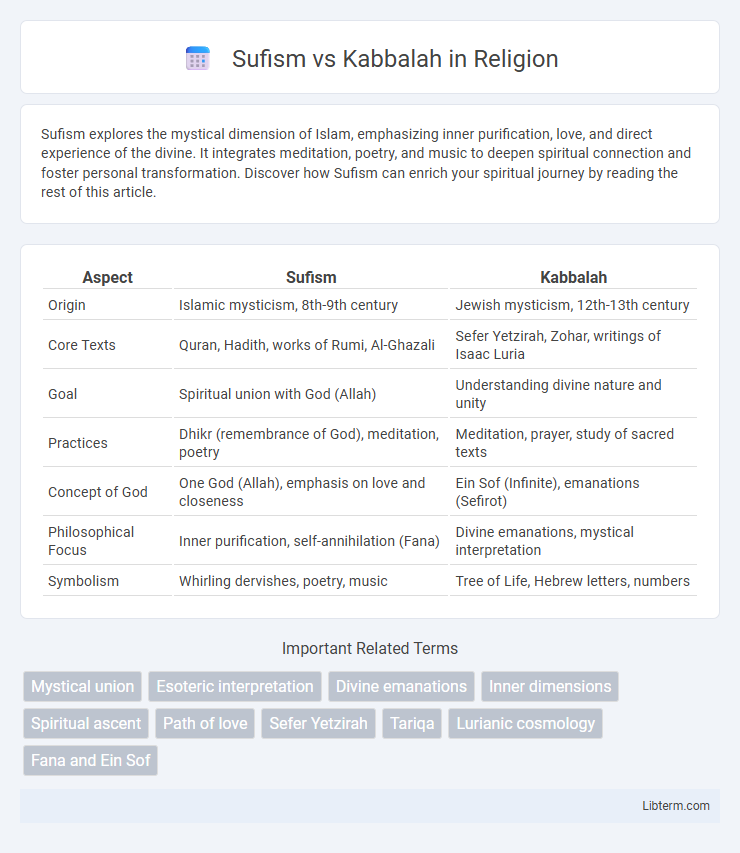Sufism explores the mystical dimension of Islam, emphasizing inner purification, love, and direct experience of the divine. It integrates meditation, poetry, and music to deepen spiritual connection and foster personal transformation. Discover how Sufism can enrich your spiritual journey by reading the rest of this article.
Table of Comparison
| Aspect | Sufism | Kabbalah |
|---|---|---|
| Origin | Islamic mysticism, 8th-9th century | Jewish mysticism, 12th-13th century |
| Core Texts | Quran, Hadith, works of Rumi, Al-Ghazali | Sefer Yetzirah, Zohar, writings of Isaac Luria |
| Goal | Spiritual union with God (Allah) | Understanding divine nature and unity |
| Practices | Dhikr (remembrance of God), meditation, poetry | Meditation, prayer, study of sacred texts |
| Concept of God | One God (Allah), emphasis on love and closeness | Ein Sof (Infinite), emanations (Sefirot) |
| Philosophical Focus | Inner purification, self-annihilation (Fana) | Divine emanations, mystical interpretation |
| Symbolism | Whirling dervishes, poetry, music | Tree of Life, Hebrew letters, numbers |
Introduction to Sufism and Kabbalah
Sufism, the mystical branch of Islam, emphasizes inner purification, divine love, and direct experiential knowledge of God through practices like dhikr and meditation. Kabbalah, the esoteric tradition within Judaism, explores the hidden meanings of the Torah and the nature of the divine through symbolic texts like the Zohar and the Tree of Life. Both spiritual paths seek deeper understanding and connection with the divine, using unique metaphysical frameworks and mystical techniques.
Historical Origins and Development
Sufism emerged in the 8th century within the Islamic world, rooted in the mystical quest for divine love and unity, drawing heavily from Quranic teachings and the Prophet Muhammad's spiritual practices. Kabbalah developed in the 12th and 13th centuries in medieval Jewish communities, particularly in Provence and Spain, synthesizing earlier esoteric traditions with a focus on interpreting the Torah's hidden meanings. Both traditions evolved as inner mystical movements aiming to deepen spiritual experience, yet they reflect distinct cultural contexts and theological frameworks central to Islam and Judaism respectively.
Core Beliefs and Philosophies
Sufism centers on the mystical experience of divine love and unity with God through practices like dhikr and meditation, emphasizing the purification of the heart and the inner journey towards spiritual enlightenment. Kabbalah explores the hidden aspects of the Torah and the nature of God through complex symbolic systems like the Tree of Life, aiming to understand the divine emanations (Sefirot) and achieve spiritual transformation. Both traditions seek a deep connection with the divine but differ in their theological frameworks: Sufism is rooted in Islamic monotheism and the direct experience of God, while Kabbalah integrates Jewish mysticism and metaphysical interpretations of sacred texts.
Spiritual Practices and Rituals
Sufism emphasizes zikr (remembrance of God) through repetitive chanting, meditation, and whirling dervishes as key spiritual practices that cultivate divine love and unity. Kabbalah involves meditative prayer, the study of the Zohar, and the use of amulets or sacred names to deepen mystical understanding and connection with the divine. Both traditions engage in transformative rituals, yet Sufism centers on the heart's purification, while Kabbalah pursues esoteric knowledge and spiritual ascent.
Mystical Interpretations of Sacred Texts
Sufism interprets Islamic sacred texts through symbolic and allegorical meanings, emphasizing inner spiritual experience and direct union with the Divine via poetry and metaphor. Kabbalah explores Jewish scriptures using gematria, mystical sefirot, and complex symbolism to reveal hidden divine attributes and cosmic structures. Both traditions prioritize esoteric knowledge to unlock deeper spiritual realities beyond literal interpretations.
Paths to Divine Union: Methods and Experiences
Sufism emphasizes the path of spiritual purification through practices like dhikr (remembrance) and whirling dance to achieve fana (annihilation of the self) and divine union with Allah. Kabbalah approaches divine union by exploring the sefirot (emanations of God) through meditative prayer, contemplation, and the study of mystical texts to attain devekut, or cleaving to the Divine. Both traditions prioritize experiential knowledge and inner transformation, guiding practitioners beyond intellectual understanding toward direct mystical experience.
Key Figures and Influential Teachers
Sufism is shaped by key figures such as Rumi, Ibn Arabi, and Al-Ghazali, whose teachings emphasize mystical union with the Divine through love and spiritual practice. Kabbalah's foundational influencers include Rabbi Isaac Luria, who developed Lurianic Kabbalah, and Rabbi Moses de Leon, credited with early Kabbalistic texts like the Zohar. Both traditions rely heavily on the transmission of esoteric wisdom through influential teachers who guide followers in exploring deep spiritual realities.
Symbolism and Sacred Language
Sufism employs rich symbolism such as the whirling dervish and the use of poetry in Persian and Arabic to express mystical union with the Divine, emphasizing allegorical meanings behind Quranic language. Kabbalah uses Hebrew letters and symbols like the Tree of Life to decode hidden meanings within the Torah, presenting sacred language as a tool for spiritual ascent and creation of divine reality. Both traditions regard their sacred languages as pathways to transcend ordinary understanding, unlocking esoteric wisdom through symbolic interpretation.
Community, Transmission, and Lineage
Sufism emphasizes the importance of the spiritual community (Tariqa) where disciples (murids) gather under a master (Sheikh) for direct transmission of esoteric knowledge through oral teachings and spiritual practices. Kabbalah traditionally relies on a lineage of scholars and rabbis who transmit mystical insights through written texts and close mentorship, preserving interpretive authenticity within Jewish communities. Both traditions value unbroken spiritual chains (silsila in Sufism, mesorah in Kabbalah) as essential to preserving the integrity and experiential depth of their mystical wisdom.
Contemporary Relevance and Interfaith Dialogue
Sufism and Kabbalah offer profound spiritual frameworks that resonate with contemporary seekers by emphasizing inner transformation and mystical experience. Their shared focus on divine unity and ethical living fosters meaningful interfaith dialogue, promoting mutual respect among diverse religious traditions. These mystical paths contribute significantly to modern discussions on spirituality, tolerance, and cross-cultural understanding.
Sufism Infographic

 libterm.com
libterm.com